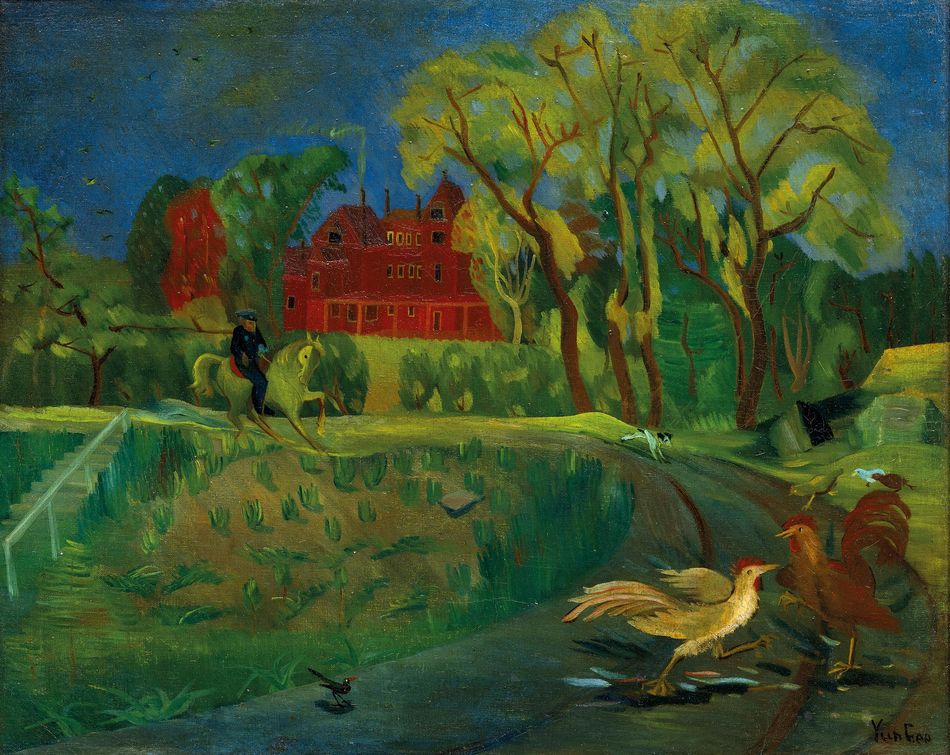

Estimate
TWD 3,200,000-5,000,000
HKD 755,000-1,179,000
USD 97,200-151,800
CNY 703,000-1,099,000
Sold Price
TWD 3,360,000
HKD 879,581
USD 112,337
CNY 807,692
Signature
PROVENANCE
Private collection, San Francisco (acquired from a private estate auction in San Francisco,
circa late1970s or early 1980s)
Private collection, Asia
+ OVERVIEW
Yun Gee was not a prolific artist, but throughout his creative career, he exhibited a distinct tendency: he often revisited and reinterpreted the same landscapes. Iconic cityscapes such as New York’s Central Park, Broadway street scenes, and the
Brooklyn Bridge— familiar to the public—were recurring subjects in his work. These urban environments, drawn from the artist’s personal surroundings, bear witness to his evolving artistic styles and transformations.In 1926, during a visit to the United States by Prince and Princess Murat of French nobility, Yun Gee’s solo exhibition
in San Francisco captured their attention and admi rat ion. Impressed by his talent, they encouraged him to pursue his artistic career in Paris. Arriving in Paris in 1927, Yun Gee was deeply inspired by the city’s cultural diversity and openness to foreign
influences. In addition to being exposed to the prevailing movements such as the School of Paris and Surrealism, he temporarily left Paris in 1928 for a six-month sketching journey in Madrid. During this time, his painting style absorbed the rich, subdued tones reminiscent of Spain’s classical masters.Yun Gee's artistic style evolved significantly over time. Moving away from his early use of bright, contrasting warm and cool color blocks, as well as influences from Synchromism and Cubism, he
gradually embraced more lyrical themes imbued with an Eastern sensibility. His compositions began to incorporate fluid, flowing lines, developing into a dynamic style characterized by a strong sense of foreground-background layering and visual depth—elements that became defining features of his landscape paintings.
This compositional approach can be seen across decades of his work, linking pieces such as Place Maubert, Paris (1929), Wheels: Industrial New York (1932), and his later work West Tower from Central Park in Winter (1952). Yun Gee’s landscapes often oscillate between the realms of fantasy and reality, portraying utopian ideals while also capturing the emotional distance and sense of disillusionment born from historical circumstances and unfulfilled aspirations. The painting The Wine House was part of a private San Francisco collection from the late 1970s to early 1980s, and was later acquired by the current owner through an estate auction of that same collection. A comparison with the exhibition catalogues published by Lin & Keng Gallery in Taipei in 1995 and 1998 reveals three related works from the 1930s and 1940s by Yun Gee: Landscape, Horse With Rider (also known as The Estate), and Estate in Winter. These pieces share strikingly similar compositions with The Wine House, each depicting the estate under varying conditions of night and winter. The elements within the painting evoke a distinctly European atmosphere—manor houses, horse mounted riders, and small countryside animals. The S-shaped composition, a hallmark of Yun Gee's artistic style, is prominently featured and further tis these works together visually and thematically. In contrast to Horse With Rider and Estate in Winter—
both of which make extensive use of black to depict a sky heavy with storm clouds or barren, claw-like branches reaching toward the heavens in a stark,
wintry chill—The Wine House, which indicates that it likely dates from an earlier period. presents a markedly brighter and warmer palette. The fresh green foliage
at the tops of the trees highlights the warmth and liveliness of the estate’s red-brick buildings and curling chimney smoke.A winding country path leads the eye from the distant background toward the foreground, where a small hunting dog runs ahead of a mounted rider. In the near distance, two pheasants engage mid-air in a fluttering skirmish, echoing a flock of birds flyingfreely across the expressive sky. Thecomposition is complete and harmonious, making this piece the largest among Yun Gee’s works on this subject. The color palette is refined, skillfully balancing movement and stillness.
The painting radiates a sense of joy and artistic serenity, offering viewers a glimpse into a world of beauty and idealism. Perhaps it is this vision—Yun Gee’s quietly cherished utopia—that he so generously and selflessly shared as a precious gift to future generations.
Modern & Contemporary Art
Ravenel Spring Auction 2025 Taipei
Sunday, June 1, 2025, 2:00pm
